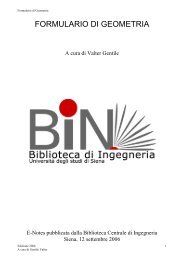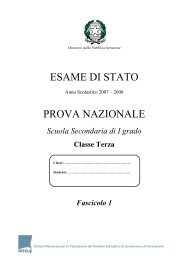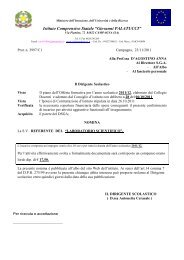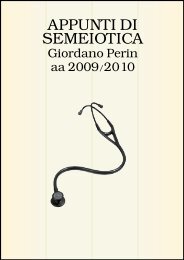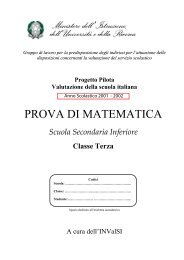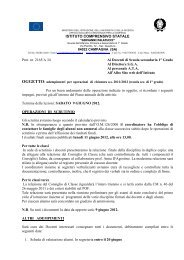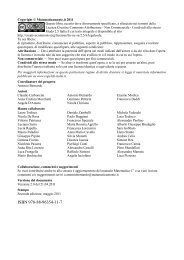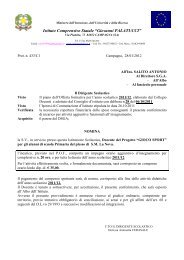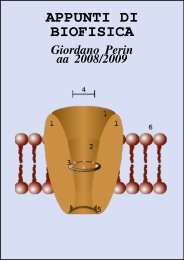- Page 1 and 2:
MATEMÁTICA… ¿ESTÁS AHÍ? Episo
- Page 3 and 4:
ESTE LIBRO (y esta colección) Exis
- Page 5 and 6:
Este libro es para mis padres, Erne
- Page 7 and 8:
Agradecimientos A Diego Golombek, d
- Page 9 and 10:
Los agujeros negros son los lugares
- Page 11 and 12:
Índice Prólogo . . . . . . . . .
- Page 13 and 14:
Prólogo La inequitativa distribuci
- Page 15 and 16:
Enseñar a pensar El mundo académi
- Page 17 and 18:
M ATEMÁTICA… ¿ESTÁS AHÍ? EPIS
- Page 19 and 20:
M ATEMÁTICA… ¿ESTÁS AHÍ? EPIS
- Page 21 and 22:
M ATEMÁTICA… ¿ESTÁS AHÍ? EPIS
- Page 23 and 24:
Los números de la matemática Un m
- Page 25 and 26:
M ATEMÁTICA… ¿ESTÁS AHÍ? EPIS
- Page 27 and 28:
M ATEMÁTICA… ¿ESTÁS AHÍ? EPIS
- Page 29 and 30:
M ATEMÁTICA… ¿ESTÁS AHÍ? EPIS
- Page 31 and 32:
M ATEMÁTICA… ¿ESTÁS AHÍ? EPIS
- Page 33 and 34:
M ATEMÁTICA… ¿ESTÁS AHÍ? EPIS
- Page 35 and 36:
M ATEMÁTICA… ¿ESTÁS AHÍ? EPIS
- Page 37 and 38:
M ATEMÁTICA… ¿ESTÁS AHÍ? EPIS
- Page 39 and 40:
M ATEMÁTICA… ¿ESTÁS AHÍ? EPIS
- Page 41 and 42:
M ATEMÁTICA… ¿ESTÁS AHÍ? EPIS
- Page 43 and 44:
M ATEMÁTICA… ¿ESTÁS AHÍ? EPIS
- Page 45 and 46:
M ATEMÁTICA… ¿ESTÁS AHÍ? EPIS
- Page 47 and 48:
M ATEMÁTICA… ¿ESTÁS AHÍ? EPIS
- Page 49 and 50:
M ATEMÁTICA… ¿ESTÁS AHÍ? EPIS
- Page 51 and 52:
M ATEMÁTICA… ¿ESTÁS AHÍ? EPIS
- Page 53 and 54:
M ATEMÁTICA… ¿ESTÁS AHÍ? EPIS
- Page 55 and 56:
M ATEMÁTICA… ¿ESTÁS AHÍ? EPIS
- Page 57 and 58:
M ATEMÁTICA… ¿ESTÁS AHÍ? EPIS
- Page 59 and 60:
M ATEMÁTICA… ¿ESTÁS AHÍ? EPIS
- Page 61 and 62:
M ATEMÁTICA… ¿ESTÁS AHÍ? EPIS
- Page 63 and 64:
M ATEMÁTICA… ¿ESTÁS AHÍ? EPIS
- Page 65 and 66:
M ATEMÁTICA… ¿ESTÁS AHÍ? EPIS
- Page 67 and 68:
M ATEMÁTICA… ¿ESTÁS AHÍ? EPIS
- Page 69 and 70:
M ATEMÁTICA… ¿ESTÁS AHÍ? EPIS
- Page 71 and 72:
M ATEMÁTICA… ¿ESTÁS AHÍ? EPIS
- Page 73 and 74:
M ATEMÁTICA… ¿ESTÁS AHÍ? EPIS
- Page 75 and 76:
M ATEMÁTICA… ¿ESTÁS AHÍ? EPIS
- Page 77 and 78:
M ATEMÁTICA… ¿ESTÁS AHÍ? EPIS
- Page 79 and 80:
M ATEMÁTICA… ¿ESTÁS AHÍ? EPIS
- Page 81 and 82:
M ATEMÁTICA… ¿ESTÁS AHÍ? EPIS
- Page 83 and 84:
M ATEMÁTICA… ¿ESTÁS AHÍ? EPIS
- Page 85 and 86:
M ATEMÁTICA… ¿ESTÁS AHÍ? EPIS
- Page 87 and 88:
M ATEMÁTICA… ¿ESTÁS AHÍ? EPIS
- Page 89 and 90:
M ATEMÁTICA… ¿ESTÁS AHÍ? EPIS
- Page 91 and 92:
M ATEMÁTICA… ¿ESTÁS AHÍ? EPIS
- Page 93 and 94:
M ATEMÁTICA… ¿ESTÁS AHÍ? EPIS
- Page 95 and 96:
M ATEMÁTICA… ¿ESTÁS AHÍ? EPIS
- Page 97 and 98:
M ATEMÁTICA… ¿ESTÁS AHÍ? EPIS
- Page 99 and 100:
M ATEMÁTICA… ¿ESTÁS AHÍ? EPIS
- Page 101 and 102:
M ATEMÁTICA… ¿ESTÁS AHÍ? EPIS
- Page 103 and 104:
Probabilidades, estimaciones, combi
- Page 105 and 106:
M ATEMÁTICA… ¿ESTÁS AHÍ? EPIS
- Page 107 and 108:
M ATEMÁTICA… ¿ESTÁS AHÍ? EPIS
- Page 109 and 110:
M ATEMÁTICA… ¿ESTÁS AHÍ? EPIS
- Page 111 and 112:
M ATEMÁTICA… ¿ESTÁS AHÍ? EPIS
- Page 113 and 114:
M ATEMÁTICA… ¿ESTÁS AHÍ? EPIS
- Page 115 and 116:
M ATEMÁTICA… ¿ESTÁS AHÍ? EPIS
- Page 117 and 118:
M ATEMÁTICA… ¿ESTÁS AHÍ? EPIS
- Page 119 and 120:
M ATEMÁTICA… ¿ESTÁS AHÍ? EPIS
- Page 121 and 122:
M ATEMÁTICA… ¿ESTÁS AHÍ? EPIS
- Page 123 and 124:
M ATEMÁTICA… ¿ESTÁS AHÍ? EPIS
- Page 125 and 126:
Los problemas de la matemática La
- Page 127 and 128:
M ATEMÁTICA… ¿ESTÁS AHÍ? EPIS
- Page 129 and 130:
M ATEMÁTICA… ¿ESTÁS AHÍ? EPIS
- Page 131 and 132:
M ATEMÁTICA… ¿ESTÁS AHÍ? EPIS
- Page 133 and 134:
M ATEMÁTICA… ¿ESTÁS AHÍ? EPIS
- Page 135 and 136:
M ATEMÁTICA… ¿ESTÁS AHÍ? EPIS
- Page 137 and 138:
M ATEMÁTICA… ¿ESTÁS AHÍ? EPIS
- Page 139 and 140:
M ATEMÁTICA… ¿ESTÁS AHÍ? EPIS
- Page 141 and 142:
M ATEMÁTICA… ¿ESTÁS AHÍ? EPIS
- Page 143 and 144:
M ATEMÁTICA… ¿ESTÁS AHÍ? EPIS
- Page 145 and 146:
M ATEMÁTICA… ¿ESTÁS AHÍ? EPIS
- Page 147 and 148:
M ATEMÁTICA… ¿ESTÁS AHÍ? EPIS
- Page 149 and 150:
M ATEMÁTICA… ¿ESTÁS AHÍ? EPIS
- Page 151 and 152:
M ATEMÁTICA… ¿ESTÁS AHÍ? EPIS
- Page 153 and 154:
M ATEMÁTICA… ¿ESTÁS AHÍ? EPIS
- Page 155 and 156:
M ATEMÁTICA… ¿ESTÁS AHÍ? EPIS
- Page 157 and 158:
M ATEMÁTICA… ¿ESTÁS AHÍ? EPIS
- Page 159 and 160:
La matemática es un juego (¿o no?
- Page 161 and 162:
M ATEMÁTICA… ¿ESTÁS AHÍ? EPIS
- Page 163 and 164:
M ATEMÁTICA… ¿ESTÁS AHÍ? EPIS
- Page 165 and 166:
M ATEMÁTICA… ¿ESTÁS AHÍ? EPIS
- Page 167 and 168:
M ATEMÁTICA… ¿ESTÁS AHÍ? EPIS
- Page 169 and 170:
M ATEMÁTICA… ¿ESTÁS AHÍ? EPIS
- Page 171 and 172:
M ATEMÁTICA… ¿ESTÁS AHÍ? EPIS
- Page 173 and 174:
M ATEMÁTICA… ¿ESTÁS AHÍ? EPIS
- Page 175 and 176:
M ATEMÁTICA… ¿ESTÁS AHÍ? EPIS
- Page 177 and 178:
M ATEMÁTICA… ¿ESTÁS AHÍ? EPIS
- Page 179 and 180:
M ATEMÁTICA… ¿ESTÁS AHÍ? EPIS
- Page 181 and 182: M ATEMÁTICA… ¿ESTÁS AHÍ? EPIS
- Page 183 and 184: M ATEMÁTICA… ¿ESTÁS AHÍ? EPIS
- Page 185 and 186: M ATEMÁTICA… ¿ESTÁS AHÍ? EPIS
- Page 187 and 188: M ATEMÁTICA… ¿ESTÁS AHÍ? EPIS
- Page 189 and 190: M ATEMÁTICA… ¿ESTÁS AHÍ? EPIS
- Page 191 and 192: M ATEMÁTICA… ¿ESTÁS AHÍ? EPIS
- Page 193 and 194: M ATEMÁTICA… ¿ESTÁS AHÍ? EPIS
- Page 195 and 196: M ATEMÁTICA… ¿ESTÁS AHÍ? EPIS
- Page 197 and 198: M ATEMÁTICA… ¿ESTÁS AHÍ? EPIS
- Page 199 and 200: M ATEMÁTICA… ¿ESTÁS AHÍ? EPIS
- Page 201 and 202: M ATEMÁTICA… ¿ESTÁS AHÍ? EPIS
- Page 203 and 204: M ATEMÁTICA… ¿ESTÁS AHÍ? EPIS
- Page 205 and 206: M ATEMÁTICA… ¿ESTÁS AHÍ? EPIS
- Page 207 and 208: M ATEMÁTICA… ¿ESTÁS AHÍ? EPIS
- Page 209 and 210: M ATEMÁTICA… ¿ESTÁS AHÍ? EPIS
- Page 211 and 212: M ATEMÁTICA… ¿ESTÁS AHÍ? EPIS
- Page 213 and 214: M ATEMÁTICA… ¿ESTÁS AHÍ? EPIS
- Page 215 and 216: M ATEMÁTICA… ¿ESTÁS AHÍ? EPIS
- Page 217 and 218: M ATEMÁTICA… ¿ESTÁS AHÍ? EPIS
- Page 219 and 220: M ATEMÁTICA… ¿ESTÁS AHÍ? EPIS
- Page 221 and 222: M ATEMÁTICA… ¿ESTÁS AHÍ? EPIS
- Page 223 and 224: M ATEMÁTICA… ¿ESTÁS AHÍ? EPIS
- Page 225 and 226: M ATEMÁTICA… ¿ESTÁS AHÍ? EPIS
- Page 227 and 228: M ATEMÁTICA… ¿ESTÁS AHÍ? EPIS
- Page 229 and 230: M ATEMÁTICA… ¿ESTÁS AHÍ? EPIS
- Page 231: M ATEMÁTICA… ¿ESTÁS AHÍ? EPIS
- Page 235: M ATEMÁTICA… ¿ESTÁS AHÍ? EPIS






